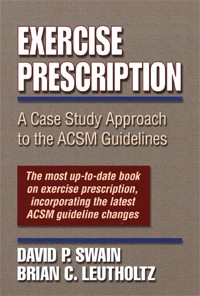Exercise Prescription
|

|
| Author: |
Swain D, Leutholtz B |
| Category: |
Sports Medicine |
| Audience: |
Academic |
| Length: |
189 pages |
| Publisher: |
Human Kinetics |
| Year Published: |
2002 |
| List Price: |
$25.00 |
|
|
|
|
AthleteInMe.com®
Rating:



 Excellent!
Excellent!
Our medical profession could use a lesson in the effectiveness of exercise as a "treatment" for many of the diseases currently affecting our sedentary society. One of the problems is that concepts like exercise, nutrition, and wellness are not extensively covered during the training of medical students or residents.
Once out in clinical practice, how does a physician learn the basic principles of exercise physiology and how to assess fitness in their patients? Answer: read Exercise Prescription. Quite simply, this is an excellent reference.
ABOUT THE AUTHORS
• David Swain, PhD is a professor of exercise physiology at Old Dominion University. His research was key in the adoption of the concept of VO2 reserve in the design of exercise plans. • Brian Leutholtz, PhD, is an associate professor of exercise physiology, also at Old Dominion.
CONTENT
- Chapter 1: Case Studies and Risk Stratification
- Chapter 2: Basic Principles of Exercise Prescription, Now With VO2 Reserve
- Chapter 3: Exercise Prescription for Cardiorespiratory Fitness
- Chapter 4: Using the ACSM Metabolic Equations
- Chapter 5: Exercise Prescription for Weight Loss
- Chapter 6: Exercise Prescription for Muscular Strength and Flexibility
- Chapter 7: Exercise Prescription for the Older Adult
- Chapter 8: Exercise Prescription for Heart Disease
- Chapter 9: Exercise Prescription for Diabetes Mellitus
- Chapter 10: Exercise Prescription for Other Special Cases
The authors have done a good job of delivering exercise physiology and other scientific concepts in a readable manner. The text contains plenty of case studies to enhance the concepts. The chapter on Muscular Strength and Flexibility contains 14 black and white photos illustrating the proper form for various exercises. References back to the original scientific publications are cited and these citations are listed at the end of each chapter.
RECOMMENDATIONS
In my opinion, this book is a must-read for physicians in primary care (eg., internists, family medicine, etc.). Heart disease and obesity are out of control in the US. Sadly, most of these cases are preventable or reversible with regular exercise. Yet, while most physicians will monitor your vital signs (resting heart rate, temperature) and assess your weight at each visit, fitness parameters are almost never assessed. Most doctors offices still don't even calculate BMI for their patients. Patients undoubtedly think, "if my doctor doesn't think it is important, then why should I worry about it?" This is not the message -- whether implied or real -- that the medical profession should convey.
Admittedly, it would be impractical in most office settings to administer a treadmill or cycle ergometer test to assess VO2. But, there are other ways to assess cardiovascular fitness. At the very least, physicians should be having discussions with their patients about exercise; just doing that would go a long way towards motivating deconditioned people to exercise more. A physician should tell their patients how much to walk and how and when to monitor their pulse. The patient can bring this information to the physician and together they can begin to develop an exercise plan.
I propose that the fundamental elements of fitness -- cardiorespiratory fitness, muscular strength, muscular endurance, body composition, and flexibility -- become the new "vital signs". These factors should become a routine part of the traditional physical exam. Physicians can then use Exercise Prescription as a valuable reference in designing exercise plans for their patients. I recommend this book highly.
Copyright ©2005 AthleteInMe, LLC. All rights reserved.
| Reviewed by: Stan Reents, PharmD |
6/2/2014 11:34:37 AM |
|